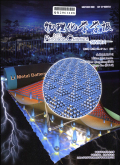物理化学学报2024,Vol.40Issue(7):43-46,4.DOI:10.3866/PKU.WHXB202307019
一种阴离子浸出策略合成金属羟基氧化物用于电催化甘油氧化
An Anion Leaching Strategy towards Metal Oxyhydroxides Synthesis for Electrocatalytic Oxidation of Glycerol
摘要
Abstract
Nucleophile oxidation reaction(NOR)is emerging as a significant approach for the sustainable production of value-added chemicals.Among the various types,electrocatalytic glycerol oxidation reaction(GOR)stands out as a crucial method for producing C1 to C3 chemicals including formic acid(FA).Non-noble-metal-based(oxy)hydroxides have found extensive use in GOR,yet achieving industrially-demanded current densities(>300 mA·cm-2)at moderate potentials remains a challenge.It is well documented that GOR catalyzed by(oxy)hydroxides follows an indirect oxidation mechanism.Specifically,the nucleophile,glycerol,undergoes oxidation by the electrogenerated oxyhydroxides with electrophilic adsorption oxygen.Therefore,comprehending the evolution of the electrocatalyst in GOR is critically important.In this paper,we have developed molybdenum-doped nickel oxyhydroxides(Mo-NiOOH)through cyclic voltammetry(CV)activation of nickel molybdate(NiMoO4).We demonstrated that Mo species leach from NiMoO4,and the resulting Mo-NiOOH retains the nanosheet array morphology of NiMoO4.We subjected the freshly prepared Mo-NiOOH to systematic characterizations employing techniques such as scanning electron microscopy(SEM),energy dispersive X-ray spectroscopy(EDS)mapping,Raman spectroscopy,inductively coupled plasma-mass spectrometry(ICP-MS),and X-ray photoelectron spectroscopy(XPS).The above structural characterizations confirm that Mo-NiOOH inherits the nanosheet array morphology of the NiMoO4 precursor with reduced Mo content,thereby indicating the phase reconstruction from oxides to oxyhydroxides post CV activation.Furthermore,the Ni3+/Ni2+ratio in Mo-NiOOH surpasses that in NiOOH derived from CV activation of Ni(OH)2.Mo-NiOOH exhibits elevated electrochemically active surface areas(ECSAs)and a higher Ni3+/Ni2+ratio compared to NiOOH obtained through CV activation of Ni(OH)2,facilitating the Mo-NiOOH exhibits higher ratio of Ni3+/Ni2+,higher electrochemically active surface areas(ECSAs)than NiOOH,and facilitated oxidation of Ni2+to Ni3+.Consequently,Mo-NiOOH requires a lower applied potential than NiOOH(1.51 V versus 1.84 V vs.reversible hydrogen electrode(RHE))to achieve a high current density(400 mA·cm-2).Additionally,Mo-NiOOH demonstrates higher Faradaic efficiency towards formate(FEformate)in contrast to NiOOH(84.7%versus 59.6%),indicating enhanced carbon-carbon(C―C)bond cleavage due to Mo doping.Multi-potential step(STEP)experiments indicate that GOR catalyzed by NiOOH and Mo-NiOOH follows a similar indirect oxidation mechanism mediated by oxyhydroxides.Operando electrochemical impedance spectroscopy(EIS)and in situ Raman spectroscopy confirmed that Mo doping in NiOOH accelerates GOR kinetics and the oxidation of Ni2+to Ni3+,contributing to the higher activity and formate selectivity of Mo-NiOOH than NiOOH.The strategy of surface modulation of oxyhydroxides through leaching of soluble anions offers guidelines for the rational design of high-performance NOR electrocatalysts.关键词
循环伏安法活化/电催化/甘油电氧化/羟基氧化物/重构Key words
CV activation/Electrocatalysis/Glycerol electro-oxidation/Oxyhydroxides/Reconstruction分类
化学引用本文复制引用
王烨,葛瑞翔,刘翔,李敬,段昊泓..一种阴离子浸出策略合成金属羟基氧化物用于电催化甘油氧化[J].物理化学学报,2024,40(7):43-46,4.基金项目
This project was supported by Beijing Natural Science Foundation,China(JQ22003),the National Natural Science Foundation of China(21978147,21935001)and Beijing Municipal Natural Science Foundation,China(2214063).北京市自然科学基金(J122003),国家自然科学基金(21978147,21935001),北京市自然科学基金(2214063)资助 (JQ22003)

